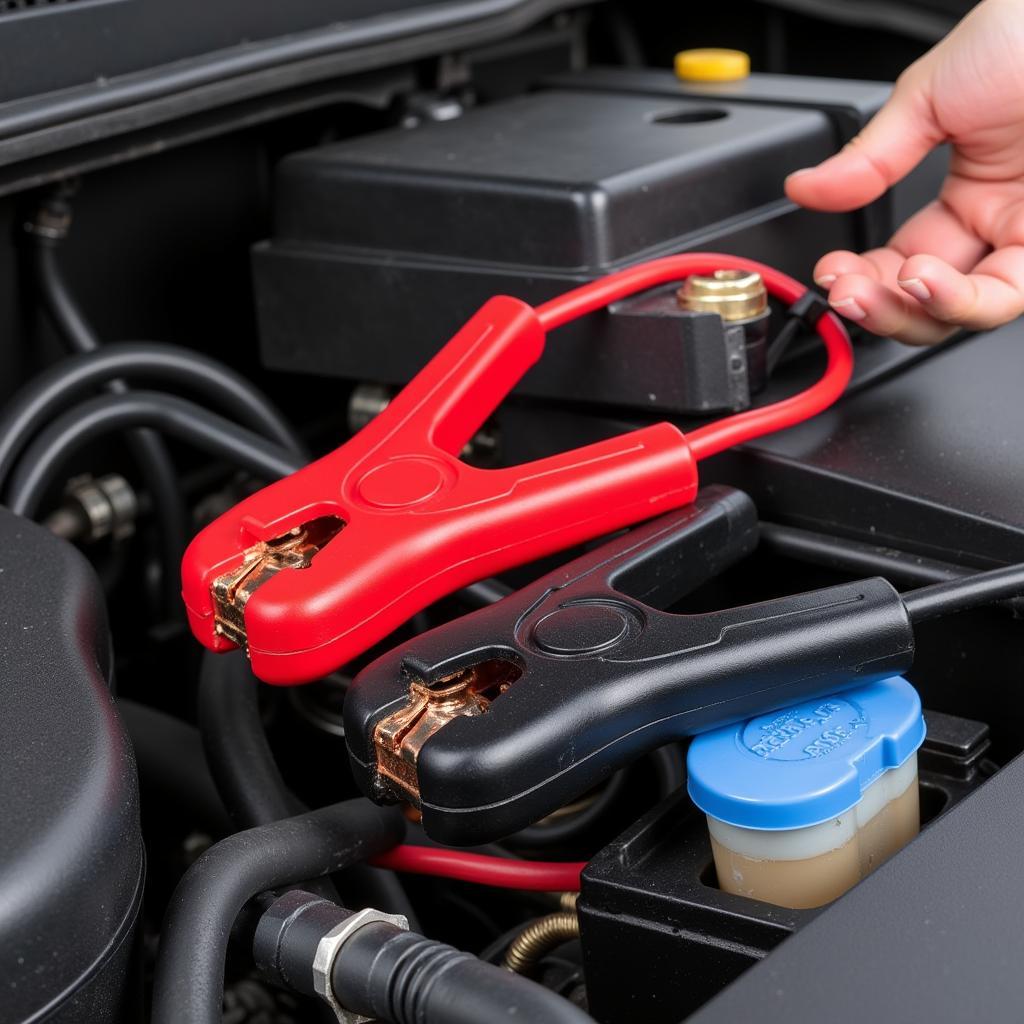Jump starting a car is a common roadside emergency procedure. Knowing how to jump start your car correctly can save you time, money, and potential damage to your vehicle. This guide will walk you through the process, offering expert advice and troubleshooting tips for a safe and effective jump start.  Connecting Jumper Cables to Car Battery
Connecting Jumper Cables to Car Battery
Understanding the Basics of Jump Starting
Before you begin, it’s crucial to understand why your car needs a jump start. A dead battery is the most common culprit, often caused by leaving lights on, extreme temperatures, or an old battery. lincoln key fob battery Sometimes, a faulty alternator can also be the issue. The alternator charges the battery while the engine is running, so a malfunctioning one will eventually lead to a dead battery.
Identifying a Dead Car Battery
Several signs indicate a dead battery, including dimming headlights, a slow engine crank, clicking sounds when turning the key, and dashboard warning lights. Once you’ve confirmed a dead battery, you’ll need jumper cables and another vehicle with a working battery.
Gathering the Necessary Tools for Jump Starting
Having the right tools makes the process smoother and safer. Essential tools include a pair of jumper cables (longer cables are preferable), safety glasses, and gloves. While gloves aren’t strictly necessary, they can protect your hands from dirt and battery acid.
Choosing the Right Jumper Cables
Jumper cables come in various gauges; thicker cables (lower gauge number) can handle more current and are recommended, especially for larger engines. Ensure the cables are in good condition, with no exposed wires or cracks in the insulation. mazda key fob battery Damaged cables can be dangerous and ineffective.
Step-by-Step Guide to Jump Starting Your Car
Now that you have the necessary tools, let’s dive into the jump-starting process.
- Position the Vehicles: Park the working vehicle close to the dead one, ensuring the batteries are accessible and the cars aren’t touching.
- Turn Off Both Vehicles: Ensure both ignitions are off and all accessories are turned off as well.
- Connect the Red (Positive) Cable: Attach one end of the red cable to the positive (+) terminal of the dead battery. Then, connect the other end to the positive (+) terminal of the working battery.
- Connect the Black (Negative) Cable: Attach one end of the black cable to the negative (-) terminal of the working battery. Then, connect the other end to an unpainted metal surface on the dead car’s engine block, away from the battery. This acts as a grounding point.
- Start the Working Vehicle: Let the working vehicle run for a few minutes to charge the dead battery.
- Start the Dead Vehicle: Attempt to start the dead vehicle. If it doesn’t start immediately, let the working vehicle run for a few more minutes and try again.
- Disconnect the Cables: Once the dead vehicle starts, disconnect the cables in the reverse order of connection: black cable from the dead car, black cable from the working car, red cable from the working car, and finally, red cable from the dead car.
Troubleshooting Common Jump Starting Issues
Sometimes, even with the correct procedure, you might encounter issues. If the dead car still won’t start, double-check the cable connections and ensure they are secure. f150 key fob A corroded battery terminal can also prevent a proper connection. Cleaning the terminals with a wire brush can help. If the problem persists, the battery might be beyond jump-starting and require replacement. how to open a prius key fob
“A common mistake is connecting the cables incorrectly. Always double-check the positive and negative connections to avoid damage,” says John Smith, Senior Automotive Technician at ABC Auto Repair.
Maintaining Your Car Battery to Prevent Future Jump Starts
Regular battery maintenance can help prevent future jump starts. This includes checking the battery terminals for corrosion, ensuring the battery hold-down is secure, and having the battery tested periodically.
“Regular battery testing can identify potential issues before they leave you stranded,” adds Jane Doe, Lead Mechanic at XYZ Auto Services. lincoln mkz key fob battery
Conclusion
Jumping your car can be a straightforward process if done correctly. Following these steps and understanding the basics can help you get back on the road quickly and safely. Remember to always prioritize safety and consult a professional if you encounter any difficulties jump starting your car.
FAQ
- How long should I let the working car run before starting the dead car? A few minutes is usually sufficient to provide enough charge.
- Can I jump start a car with a different voltage battery? It’s generally not recommended, as it can damage both batteries.
- What should I do if the dead car still won’t start after jump starting? Check the cable connections, clean the battery terminals, or consider replacing the battery.
- Is it safe to jump start a car in the rain? Yes, but exercise extra caution to avoid electric shock.
- How often should I have my car battery tested? Every six months or so is a good practice.
- What are the signs of a bad alternator? Dimming headlights, flickering dashboard lights, and a dead battery are common signs.
- Can jump starting a car damage the electronics? It’s possible, but unlikely if done correctly.

